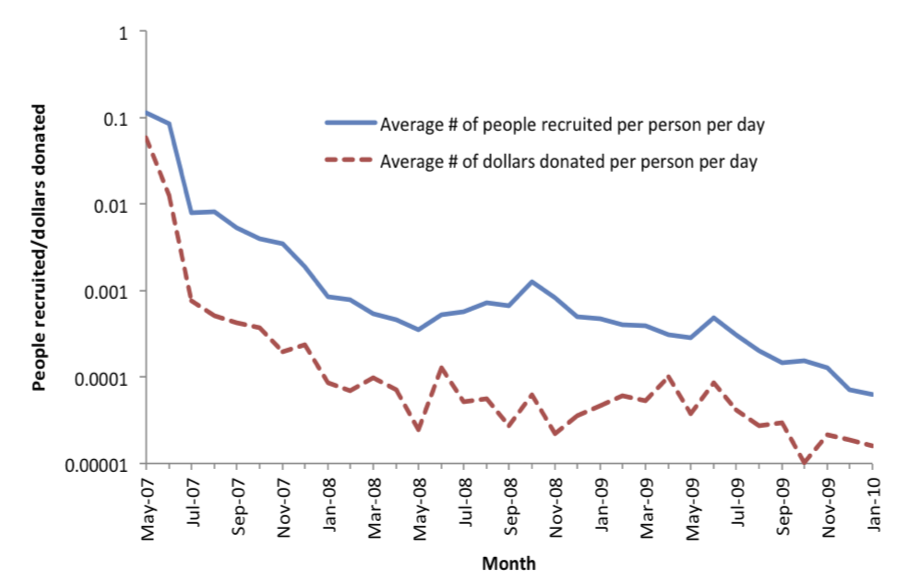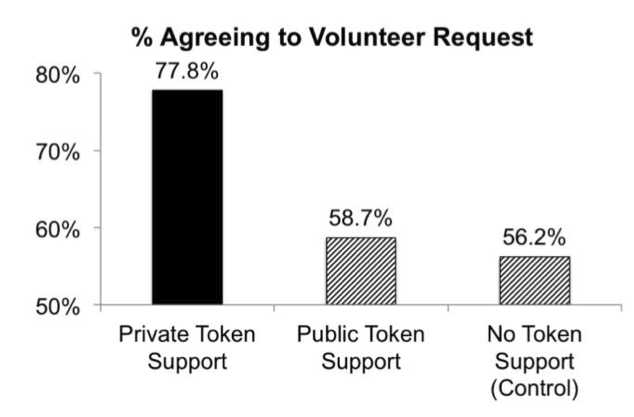Over at orgtheory.com, Brayden King pointed to two recent studies on online activism. In their study on “The Structure of Online Activism” (PDF), published in the newly founded Open Access journal Sociological Science, Kevin Lewis, Kurt Gray and Jens Meierhenrich investigate participation around a Facebook “Cause” on Darfur. “Causes” is a platform for online activism which is linked to and builds upon Facebook and the latter’s possibility to recruit your Facebook friends for a certain cause. The cause under study was a campaign on Darfur with over 1.2 million supporters. The authors had access to great longitudinal network data and investigated how the decision to publicly support the cause on Facebook had translated into further support later on. The disillusioning result (p. 2):
99.76 percent of members never donated[.]
To a certain degree, the results of the paper corroborate what is known as the 1% rule on the internet. The overly large majority of an online community contributes nothing, only one percent is responsible for nearly all of the content; in the Darfur case even fewer people (0.24 percent) contributed in form of donations. Compared to traditional forms of mobilizing this is a very poor conversion rate, as reported by Lewis et al. (p. 4):
Mail solicitations, meanwhile, typically generate rates of 2 percent to 8 percent of people donating $10 to $50 each[.]
Furthermore, activism levels decreased quickly over time (see Figure 1).

Figure 1: Decline of individual participation shown via a final portrait of the evolution of the Save Darfur Cause (taken from: Lewis et al. 2014, S. 6)
Another study by Kris Kristofferson, Katherine White and John Peloza on “The Nature of Slacktivism” (PDF) offers at least some explanations for the findings presented above. They define “Slacktivism” as follows:
We define slacktivism as a willingness to perform a relatively costless, token display of support for a social cause, with an accompanying lack of willingness to devote significant effort to enact meaningful change.
The core hypothesis of the paper is that publicly engaging in activism on Facebook and elsewhere also satisfies impression-management motives, leading to a lower likelihood of engaging in subsequent support than when the initial token support is private. In other words, since the supporting ‘click’ is public, the goal of appearing socially engaged is immediately reached, no further effort is necessary. Contrary to such a logic is one where engagement is driven by activism that is consistent with pre-existing values.
To test their hypothesis, the authors conducted a series of field and lab experiments and showed that people who are assigned to publicly show their activism are less likely to engage for the cause subsequently (stuffing envelopes) than are people who are assigned to first show private support. In one of their experiments, the key variation is in the privacy settings of a Facebook group.

Figure 2: Percentage of participants agreeing to subsequent volunteer support request (taken from: Kristofferson et al. 2014, S. 10)
Across all (online and offline) experiments publicly displayed activism seemed to satisfy individuals’ need for impression management and reduced likelihood of further engagement (see Figure 2). In the Facebook version of the experiment, the authors managed to compensate for this effect by reminding participants of their own previously stated values (something they call “value alignment”).
Taken together, the two studies demonstrate at least two things. First, decreasing communication costs and new networking tools need not automatically lead to more engagement. Quite to the contrary, more digital visibility of one’s support, which is often seen as a pre-condition for viral effects, can reduce the probability of further, more sustainable activism. Second, the negative effect of public visibility is not deterministic but can be compensated for; of course, this compensation requires additional and specific efforts. Furthermore, there are also non-public ways of activism online that are championed by online activism platforms such as moveon.org, which still mostly rely on simple e-mail communication.
From a theoretical perspective, the potential trade-off between virality and sustainability of activism adds another layer to Rao’s distinction between “hot cause” and “cool mobilization”. In his book “Market Rebels“, Rao (2008) argues that successful social movements require a combination of a “hot cause” that evokes emotional responses with the “cool mobilization” for maintaining commitment and involvement of the movement’s members. In this regard, the papers on online activism discussed above give another explanation why a hot cause with a lot of publicly displayed support is rarely enough for lasting mobilization success.
(leonhard)



2 comments
Comments feed for this article
April 22, 2014 at 08:42
Die Logik der Kaskade | Alexander von Humboldt Institut für Internet und Gesellschaft
[…] Bewegung oder die Popularität von Katzenbildern (wobei Verbreitung nicht mit unbedingt mit nachhaltiger Wirkung gleichgesetzt werden […]
April 22, 2014 at 08:43
The logic of cascades | Alexander von Humboldt Institut für Internet und Gesellschaft
[…] Why do certain pieces of information spread much more widely than others, and what factors play a role in information diffusion? Scientists from different fields now study such processes under labels such as web science and computational social science. They analyze vast amounts of data, for example with the goal of determining the most salient factors which contribute to the spread of a particular piece of information. Increasingly it is possible to track such processes in real time on platforms such as Twitter, Facebook or Google Plus, assuming one has access to the data. This allows the description of an ad campaign with the same methodology as the success of a political campaign or the popularity of cat content (though it is best not to confuse sharing with long-term engagement). […]